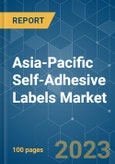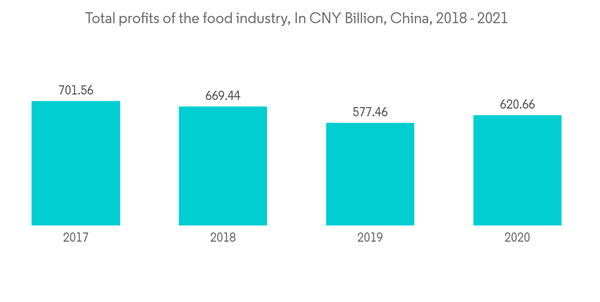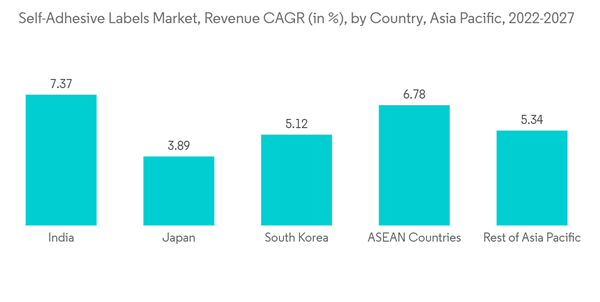Due to the COVID-19 pandemic, the market of self-adhesive labels in the region was negatively impacted. The implementation of the lockdown in the region led to supply chain constraints that significantly obstructed the expansion of the industry. However, the market recovered in 2021 and is expected to grow at a significant rate in the coming years.
Key Highlights
- Over the short term, major factors driving the market studied are the growing e-commerce industry in the region and the increasing demand for packed goods from the food and beverage industries.
- On the flip side, the availability of substitute products in terms of adhesive used in the market is expected to hinder the growth of the market studied.
- Nevertheless, shifting focus toward bio-based self-adhesive labels is likely to act as an opportunity for the market studied.
- China is dominating the Asia Pacific self-adhesive labels market and is expected to remain in a dominant position over the forecast period.
APAC Self-Adhesive Labels Market Trends
Increasing Demand from Food and Beverages Industry
- The food and beverage industry is among the major sectors creating a significant demand for self-adhesive labels and is contributing as the largest end-user industry for self-adhesive labels in the region.
- Self-adhesive labels are known to improve the aesthetic characteristics of food and beverage packaging brands. In the food and beverage packaging industry, self-adhesive labels help perform a major function in product authentication and tamper-evidence.
- In the food and beverage sector, labeling is done to provide ingredient information, product identification, and cautionary notifications. The self-adhesive label manufacturers need to take care of the legal requirements put in place to ensure that the adhesive does not affect the food ingredients.
- In Asia-Pacific, owing to lifestyle changes, the growing disposable income of people, an increase in the number of working professionals, and the growing preference for fast food, are propelling the demand for packaged food, especially in the countries such as China, India, and Japan.
- The total profits of the food industry in China are witnessing a slightly decreasing trend over the past few years. According to the Ministry of Industry and Information Technology of the People's Republic of China, the total profits of the food industry in China accounted for CNY 618.71 billion (USD 97.08 billion) in 2021, compared to CNY 620.66 billion (USD 95.09 billion) in 2020.
- In December 2021, the beverage output in China amounted to 13.59 million tons, registering a growth rate of 8.3% year on year.
- India is the 2nd largest country in term of population and is observing significant growth in the food and beverages industry. According to the Indian Brand Equity Foundation (IBEF), the Indian processed food market is expected to expand to USD 470 billion by 2025.
- Moreover, in India, according to the Department for Promotion of Industry and Internal Trade (India), the proposed investment value in the food processing industry accounted for INR 127.81 billion (USD 1.55 billion) in FY 2021, compared to INR 67.81 billion (USD 0.82 billion) in FY 2020.
- In Japan, according to the Food Export Association, the retail sales in the packaged food market in Japan accounted at USD 216.3 billion in 2022, registering a growth of around 10.5% as compared to previous year.
- Owing to all the above facts, the demand for packaging material in the food industry is expected to increase, which, in turn, is expected to boost the demand for self-adhesive labels over the forecast period.
China to dominate the Asia Pacific Market
- China is the largest country by area in the Asia-Pacific region and is the largest country in terms of the population globally. The Chinese market for self-adhesive labels is expected to remain in the top position in the region as well as globally, owing to huge demand from food and beverages and pharmaceutical industries in the country.
- China is the world's largest food and beverages and pharmaceutical market in terms of total production.
- According to the National Development and Reform Commission, the food industry in China registered a steady expansion in 2021 in terms of production and sales. In 2021, the revenue of the Chinese food market was USD 1,181.63 billion compared to USD 1,054.19 billion in 2020. The value-added industrial output of the food manufacturing sector increased by 8% annually in 2021.
- Furthermore, in 2021, the wine, beverage, and refined tea production sectors registered an industrial value-added increase of 10.6% when compared to 2021.
- In the future, China’s food market is expected to grow over the forecast period, due to various factors such as the average household income, rapid rise in the middle-class population improvements in infrastructure for food distribution, and the increasing sales of e-commerce for food.
- The pharmaceutical sector is one of the key industries in China's continued economic development. Since joining the World Trade Organization, China's pharmaceutical industry has made rapid progress. According to the National Bureau of Statistics, the pharmaceutical sector generated CNY 3.3 trillion (USD 0.47 trillion) in 2021 as compared to CNY 2.7 trillion (USD 0.39 trillion) in 2020.
- Hence, owing to the above-mentioned factors, China is expected to dominate the Asia-Pacific self-adhesive labels market during the forecast period.
APAC Self-Adhesive Labels Market Competitor Analysis
The Asia-Pacific self-adhesive labels market is partially fragmented in nature. Some of the major key players in the market include (not in any particular order) 3M, Avery Dennison Corporation, H.B. Fuller Company, Fuji Seal, Inc., and LINTEC Corporation.Additional benefits of purchasing the report:
- The market estimate (ME) sheet in Excel format
- 3 months of analyst support
This product will be delivered within 2 business days.
Table of Contents
1 INTRODUCTION1.1 Study Assumptions
1.2 Scope of the Study
2 RESEARCH METHODOLOGY
3 EXECUTIVE SUMMARY
4 MARKET DYNAMICS
4.1 Drivers
4.1.1 Growing E-Commerce Industry in the region
4.1.2 Increasing Demand for Packed Goods from Food and Beverage Industries
4.2 Restraints
4.2.1 Availability of Subsitutes
4.2.2 Other Restraints
4.3 Industry Value Chain Analysis
4.4 Porter's Five Forces Analysis
4.4.1 Bargaining Power of Suppliers
4.4.2 Bargaining Power of Buyers
4.4.3 Threat of New Entrants
4.4.4 Threat of Substitute Products and Services
4.4.5 Degree of Competition
5 MARKET SEGMENTATION
5.1 By Adhesive Type
5.1.1 Hot Melt
5.1.2 Emulsion Acrylic
5.1.3 Solvent
5.2 By Face Material
5.2.1 Paper
5.2.2 Plastic
5.2.2.1 Polypropylene
5.2.2.2 Polyester
5.2.2.3 Vinyl
5.2.2.4 Other Plastics
5.3 By Application
5.3.1 Food and Beverage
5.3.2 Pharmaceutical
5.3.3 Logistics and Transport
5.3.4 Personal Care
5.3.5 Consumer Durables
5.3.6 Other Applications
5.4 By Geography
5.4.1 China
5.4.2 India
5.4.3 Japan
5.4.4 South Korea
5.4.5 ASEAN Countries
5.4.6 Rest of Asia-Pacific
6 COMPETITIVE LANDSCAPE
6.1 Mergers and Acquisitions, Joint Ventures, Collaborations, and Agreements
6.2 Market Share (%) Analysis**/Ranking Analysis
6.3 Strategies Adopted by Leading Players
6.4 Company Profiles
6.4.1 3M
6.4.2 Avery Dennison Corporation
6.4.3 CCL Industries
6.4.4 DuPont
6.4.5 Fuji Seal, Inc.
6.4.6 H.B. Fuller Company
6.4.7 JK Labels
6.4.8 LINTEC Corporation
6.4.9 Multi-Color Corporation
6.4.10 Multipack Labels
6.4.11 Symbio, Inc.
6.4.12 ThaiKK Co. Ltd.
6.4.13 UPM
7 MARKET OPPORTUNITIES AND FUTURE TRENDS
7.1 Shifting Focus Towards Bio-based Self-Adhesive Labels
Companies Mentioned (Partial List)
A selection of companies mentioned in this report includes, but is not limited to:
- 3M
- Avery Dennison Corporation
- CCL Industries
- DuPont
- Fuji Seal, Inc.
- H.B. Fuller Company
- JK Labels
- LINTEC Corporation
- Multi-Color Corporation
- Multipack Labels
- Symbio, Inc.
- ThaiKK Co., Ltd.
- UPM
Methodology

LOADING...










